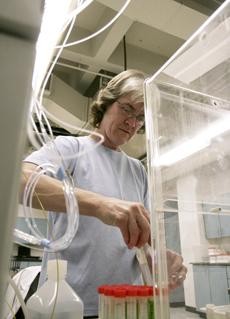The tap water you drink at home could contain traces of estrogen, insecticide and even Viagra. Researchers at the Arizona Lab for Emerging Contaminants are working to find out what threat these chemicals may pose.
ALEC is a joint effort between the UA colleges of science, pharmacy, engineering and agriculture, and life sciences. Its goal is to provide researchers with the necessary tools to study water quality.
“”We just want to be able to provide opportunities for researchers and student researchers to do research that in itself is very interesting,”” said Co-Director of ALEC Jon Chorover. “”Now students and faculty can design experiments to better test water treatment facilities.””
The tap water that most people ingest contains a very low concentration of potentially harmful chemicals, said
Chorover. There are, however, a number of compounds that could be harmful, but researchers have only recently learned about them.
“”Some of them likely do have significant health effects even at low concentrations. “”That’s sort of the state of our knowledge right now,”” said Chorover. “”There’s a lot of research going on into the health effects of these compounds so that’s a really difficult question to answer.””
One project that ALEC is currently working on is looking at the water quality of four major metropolitan cities to find traces of compounds that have hormonal effects on the endocrine system.
“”We’re looking at the water going into drinking water distribution systems as they’re distributed throughout the city and then also water that’s coming out of waste water treatment plants because that’s where we think a principle urban source for these compounds is,”” said Chorover.
According to Chorover, waste water treatment plants do sterilize the water before it is distributed but their process can only kill bacterial pollutants and metals. They don’t have the equipment to deal with the types of contaminants ALEC is working on.
“”The organic contaminants tend to make it through the waste water treatment plants,”” he said. “”People could be ingesting these compounds just by drinking tap water.””
He also said that just because technology allows scientists to find these types of chemicals, that doesn’t mean people should be alarmed that they could be drinking harmful water.
“”We develop better and better technology for being able to measure things down to very low levels so we are invariably going to be able to find things that we couldn’t find before,”” he said. “”Just because we can now measure things that we couldn’t measure before doesn’t mean there is reason to be overly concerned.””
ALEC has been in operation since August 2008 and is funded by the National Science Foundation. It also receives funds from the state of Arizona including the water sustainability program at the UA.
Mary Kay Amistadi, a research specialist in the department of soil, water and environmental science, works in the lab to help student researchers get the right data.
“”I enjoy seeing the new techniques that are being incorporated into the lab,”” she said. “”It’s pretty exciting to be on the cutting edge of lab equipment.””
Chorover said it takes a well-trained employee to use this kind of equipment and to find these compounds in the water.
“”Water contains all sorts of stuff which makes it like looking for a needle in a haystack,”” he said. “”We want to be able to separate out the compounds of interest from the rest of the stuff.””
Samanthi Wickramasekara, a post doctorate in chemistry, is currently working on the project that involves detecting endocrine disrupting compounds.
“”Once I get more hands-on experience with my post doctorate, I can begin helping students,”” she said. “”That’s my goal.””
Chorover said Arizona is a perfect place for a lab like this, which is relatively uncommon in the United States, and that the UA has a great deal of creative energy from people working in this field.
“”The University of Arizona has a wealth of expertise in the general area of water science and engineering and probably one of the best universities in the country for this area,”” he said. “”It makes sense that there should be a lab dedicated to trace pollutants in water at the university.””









